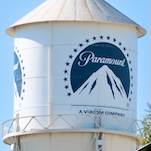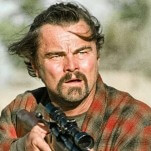One of Wanger and Siegel’s riskier decisions was the use of real-life inmates to play most of the film’s non-speaking parts, which lends the riot sequences an extra charge of palpable fury. The main cast, however, features some of the era’s juiciest character actors putting their inimitable stamps upon some otherwise stock roles. Neville Brand, who had a peculiarly half-formed face that made him look as if his genes had gotten stuck midway through adolescence, plays the riot’s chief instigator, James Dunn, a fundamentally decent guy determined to improve conditions even if it means killing some of the guards he and his fellow inmates have taken hostage. The threat of violence is better represented, however, by Leo Gordon (who had actually done time for armed robbery, and was reportedly feared by the Folsom community) as the aptly named Crazy Mike Carnie, who’s clearly more interested in wreaking havoc than in righting wrongs. Meanwhile, the movie also depicts the efforts of the warden (Emile Meyer, familiar as the corrupt cop in Sweet Smell Of Success) to achieve a fair negotiation with minimal destruction or loss of life—Cell Block 11 is the rare prison movie that doesn’t make the warden a cartoon baddie.
Because Wanger wanted to make it clear that the problem was widespread, he insisted on opening the film with a newsreel montage showing a wave of riots in prisons across the country, of which this particular riot would merely be the latest. That makes Cell Block 11 a bit slow to get rolling, and it’s subsequently hindered by some graceless scenes featuring discussions of overcrowding, understaffing, and the poor pay that requires guards to work multiple jobs (ensuring that they’re too exhausted to treat inmates respectfully). When Siegel focuses on the riot itself, though, he provides enough kinetic mayhem to bulldoze through the preachiness. In particular, he makes superb use of Folsom’s imposing two-tiered cell blocks, frequently stationing the camera at one end and the actors at the other in a way that emphasizes the building’s unforgiving isolation even more than cramped cells would. The environment seems to bleed into the inmates’ grievances, lending them a legitimacy even though we’re never really shown any mistreatment (since the film proper begins when the riot does).
That said, it’s unclear whether the Criterion DVD/Blu-ray accurately frames that environment. The company is renowned for its commitment to preserving films on video as they were originally shown in theaters, especially with regard to correct aspect ratios. When it comes to movies made in the mid-1950s, that can be a tricky business, as the industry was undergoing rapid and chaotic change due to the sudden advent of widescreen. Criterion recently released On The Waterfront (made the same year as Cell Block 11) in three different ratios, but they’ve taken a more dogmatic approach in this instance. “After extensively researching the aspect ratio history of Riot In Cell Block 11,“ the accompanying booklet states, “Criterion found that theaters projected the film in aspect ratios ranging from 1.37:1 to 1.85:1. We are presenting the film here at 1.37:1”—in the old, nearly square Academy ratio, in other words. No justification is given for this decision (at least in the booklet), and some have argued—pretty fiercely—that Siegel composed the film for a much wider ratio, while merely protecting it for 1.37. That said, it doesn’t remotely look bad in Academy, and masking the top and bottom of the frame would surely have diminished the power of Siegel’s shots of Folsom’s long, endless corridors. Purists can always mask their TV sets, if desired. The choice may be a bit questionable, but there’s no need to start a film-nerd riot over it.









































